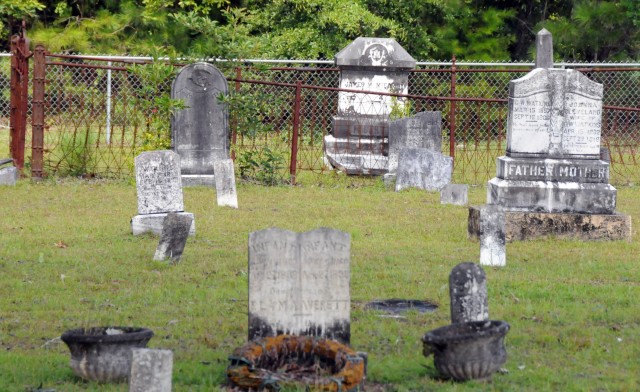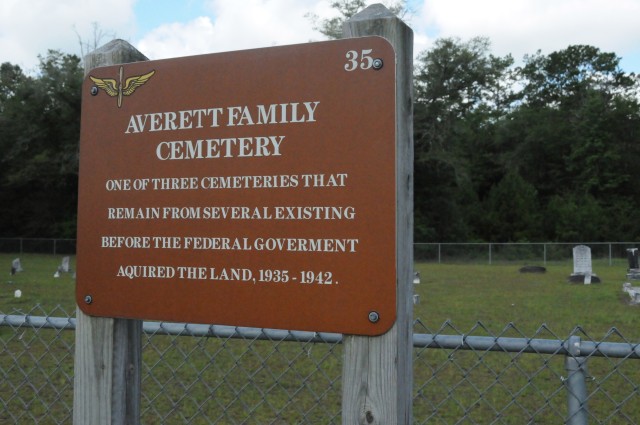FORT RUCKER, Ala. -- Before Fort Rucker became an Army Aviation training post, it was home to small pre-Civil War farms and plantations.
Part of that history is linked to four cemeteries located within the post's boundaries. The cemeteries are reminiscent of the early pioneer settlers who moved into Southeast Alabama.
According to local Historian Val McGee's book, "The Origins of Fort Rucker," these families began moving into Alabama's lower Southeast corner more than 200 years ago.
McGee indicates that in the years leading up to the Civil War, wealthy farmers built two large plantations in a community named Westville located about two miles west of what is now Lake Tholocco.
These farmers were known as Cincinnatus D. Crittenden, of Shellman, Ga., and Isaac Ardis, of Pike County. In addition to these two wealthy Families, others moved to and staked claims on smaller areas of land.
These farmers brought only needed assets such as animals and farm equipment. The descendants of these early settlers, who made their living off the land, are said to be buried in these four cemeteries.
The cemeteries are owned and maintained by the government, according to Tim Edwards, a curator at the U.S. Army Aviation Museum, however, local churches volunteer to clean and beautify the cemeteries. All are fenced and have easy access with the exception of Clayhill Cemetery, which is located near a Fort Rucker training area.
Beulah Cemetery
Beulah Cemetery is located in the area where the Old Beulah Primitive Baptist Church was established in the mid-19th century along what is now known as Andrews Avenue, about 0.3 miles inside the Ozark Gate.
According to a survey conducted Nov. 25, 2002, by Dale County Genealogical/Historical Society, there are 56 unidentified graves and more than 90 marked graves.
The earliest noted marker is dated Oct. 11, 1870, and the most recent June 30, 2000. There are several headstones that also have veteran markers alongside them from the Civil War-, World War I- and World War II-eras. The Beulah Church originally established the cemetery for its members and their families.
Byrd Family Cemetery
Byrd Family Cemetery is located north of Lake Tholocco's West Beach. This is the smallest of the four cemeteries.
According to another DCGHS survey conducted Dec. 6, 2002, the Byrd Family Cemetery is one of the three cemeteries that remained from several existing before the federal government acquired the land between 1935 and 1942. Historical records indicate that the first Byrd family that moved into this area was a young couple named Bright and Gracey Byrd. The cemetery's earliest marker is that of John C. Byrd, a third-generation grandson of the young couple. He died June 21, 1871.
Clayhill Cemetery
Clayhill Cemetery is located about 0.8 miles south of Highway 27. The entrance is blocked with a locked gate and fence due to being located near a range training area. Edwards said Clayhill is the resting place of Crittenden, Ardis and various others.
The cemetery was built adjacent to Clayhill Church by emancipated slaves around 1865, he added. The exact number of graves has not been determined due to cement discs and river rocks being placed as grave markers, but researchers have estimated there are more than 100 burial sites.
Averett Family Cemetery
Averett Family Cemetery is enclosed in a chain link fence and located at the south end of Lowe Army Airfield. This cemetery is the oldest of the four cemeteries with its earliest marker dating back to 1854.
According to an article by Meredith Keller that appeared in the Feb. 13, 1975, issue of the Army Flier, the homestead farm was established in 1843 by Philip McCarty and his family. Two of the McCartys' daughters married Annias and Marion Averett, which Keller said created a bond between the two pioneer families. This cemetery has been used by both families' descendants.
People wishing to visit Clayhill Cemetery must obtain permission from the Public Affairs Office.
For more information, call 255-2474.






Social Sharing